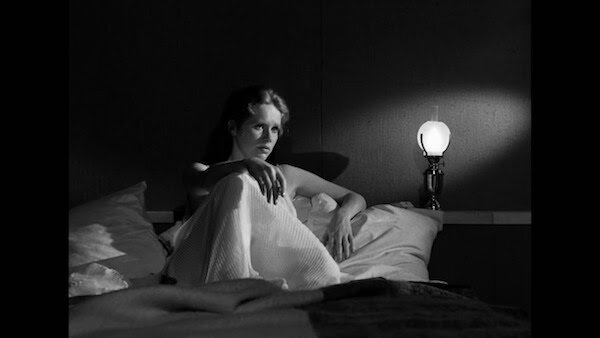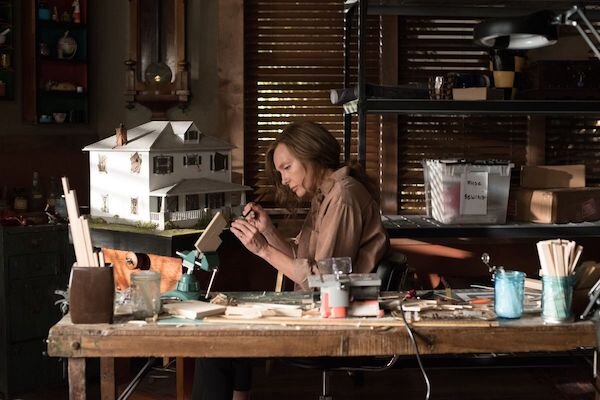Sometimes the greatest fears lie close to the heart. In two films separated by half a century, Madeleine Seidel explores how the haunted house takes on new, specifically gendered meaning, Spoilers lie within.
It is a cliché to suggest that a film’s setting takes on a life of its own, just like a character would. Streets and buildings don’t grow, and even though the summer heat may hum, it’s never talking. The anthropomorphised way setting tends to be discussed in film writing undermines the way it gives characters space to react to, and against, the confines of their surroundings, and the real-world ideologies those surroundings represent. Despite the decades of movie history that separate them, Swedish auteur Ingmar Bergman’s Persona and the runaway hit Hereditary from horror wunderkind Ari Aster utilise setting in a similar way to amplify the underlying gender commentaries within both films. The house is not only a setting, but a symbol for the claustrophobic societal restraints placed on women’s performance to perform motherhood, femininity, and grief.
Aster’s horror wonder Hereditary opens with a funeral: artist Annie Graham is burying her secretive and combative mother. Experiencing a difficult time processing her grief—or lack thereof— she quarrels with her teenage son Peter, withdraws from her husband Steve, and pours herself into her work by constructing a series of architectural miniatures that reflect their family conflicts. Annie and Peter’s younger daughter Charlie starts displaying abnormal and disturbing behaviour, before she is killed in a shocking accident involving her brother. This propels Annie further into her grief, and the family start seeing hallucinations of each other’s violent demises and sensing Charlie’s spirit still lingering in the house. After a terrifying incident involving a medium, Annie realises that the family’s recent paranormal encounters stem from her late mother’s involvement in a Satanic cult, and the malevolent spirit in the house will not rest until it finds a suitable host in one of the family members.
Bergman’s Persona is not a horror film in the most traditional sense, but it addresses equally psychological horror found within shared gendered experiences. A young mental hospital nurse named Alma is on the brink of marriage, and presumably renouncing her career to become a wife and mother. Her sense of self is thrown into question when she is assigned to the care of Elisabet Vogler, an actress who has fallen mute in a supposed mental breakdown. The hospital’s lead psychologist instructs Alma to continue Elisabet’s care at her isolated beach house in order to get the high-profile patient the necessary medical attention her puzzling case requires. During treatment, Alma begins to confide her fears of marriage and adulthood in hopes that Elisabet will verbally respond. Over the course of Elisabet’s care, the two begin to see their personalities and traumas intertwine, concluding with Alma and Elisabet’s shocking confrontation and the revelations of Elisabet’s maternal guilt and Alma’s fears of entering into the strict confines of marriage.
Both films have marked aesthetic similarities, with the most visually striking being that the home is the dominant setting to a nearly claustrophobic level, making each one a veritable pressure cooker of emotional distress. In the case of Persona, the “home” is the beach house in which Alma attempts to treat Elisabet for her muteness. It is a well-appointed yet austere location, letting the focus remain on the characters and their growing conflict. The only lushly decorated room in the beach house is Elisabet’s elegantly appointed yet cozy bedroom: a space of freedom and comfort, and the setting where Alma feels safe enough to confide in Elisabet about her abortion and extramarital sexual partners. The Graham household in Hereditary is similarly sparse, but, as the setting of a horror film, it leans into some of the typical aesthetics of the genre; dim, nearly green-tinged lighting, secret spaces, and an overall feeling of decay created by the creaking floorboards and unkempt attic. Comparable to Elisabet’s bedroom in Persona, Annie’s studio is where she finds refuge by using miniatures to illustrate her perspective of the two tragedies the Grahams are experiencing. Annie’s artistic practice becomes an extension of Aster’s filmic world-building: just as the director creates a setting to heighten and explain on-screen conflict, Annie is creating a visual component to work through her own turmoil.
The symbolism of the home is largely rooted in antiquated concepts of femininity and the 20th-century “cult of domesticity.” In post-war America, the archetype of the “happy housewife [heroine]” was celebrated and promoted in films and magazines. Under the influence of this pervasive and misogynistic ideology, many women — predominantly white women who had financial security as a result of their husbands’ jobs and generational wealth — retreated from their careers in favour of marrying early, rearing children, and working in the household. In 1963, Betty Friedan’s landmark text The Feminine Mystique analysed this so-called “problem that has no name” where women were pigeonholed into giving up building careers or lives outside the home, in favour of pursuing the often thankless roles as wives and mothers; and as a result, breeding depression, anger, and resentment in these women. The key conflicts in Persona and Hereditary mirror the internal crises of Friedan’s housewives – unfulfilled and angry at the societies that promised them happiness if they behaved as nurturing and sweet as they were told – but pushes it to the most nightmarish of conclusions.
The climax of Persona takes place in one of the most gendered and traditionally female-dominated spaces in the home: the kitchen. Sitting around the kitchen table, Alma—whose consciousness is now more or less fused with Elisabet’s—discloses her theories as to why Elisabet became mute, saying that it was a purposeful act against her role as mother to her young son. While Bergman fixes the camera on Elisabet’s emotionally distraught yet empty visage, Alma reveals that Elisabet never wanted to be a mother and attempted to induce miscarriage while she was pregnant. As a result, Elisabet cannot emotionally connect with her child and simultaneously feels guilty for her detachment and anger towards the way her theatre career has been sidelined. This shattering confession is not included to shame Elisabet, but instead to give her a chance to grieve the life she had before submitting to societal expectations.
While Bergman explores the more existential side of Alma and Elisabet’s fears, Aster uses physical violence to shatter Annie’s motherly veneer. Following Charlie’s death, Annie’s relationships with Peter and Steve become increasingly strained. In an attempt to work through her grief and meet gallery deadlines, she creates graphic dioramas that depict her mother and Charlie’s deaths. When Steve walks into Annie’s studio and discovers them, he is shocked and disgusted by his wife’s gruesome depictions, although Annie explains that this is her way of processing her profound loss. The studio, like Elisabet’s bedroom, is a place of refuge in the home where the protagonists feel safe working through their grief, fears, and anger regarding the female experience, but Steve and Annie’s intense confrontation over the dioramas clearly outlines how other characters are becoming increasingly unsettled by her behaviour.
The domestic realms in Hereditary and Persona trap their characters within harmful and intensely realised gender dynamics. As audiences become even more receptive to cinematic explorations of societal grievances, filmmakers have the opportunity to investigate the potential harm caused by conservative “family values”-based systems that prioritise heteronormativity and female submission above the equality and happiness that should be present in the family unit. Although Bergman and Aster use more mystical and horrific means for introspection, these close internal analyses that centre on mother figures interacting within the domestic sphere, show firsthand the guilt, pain and fury that can accompany experiences of motherhood and femininity. Hereditary and Persona eclipse the haunted house tropes so often seen on film, but our homes are still just as possessed by the generations of women society left in its wake. Sometimes, home is where the horror is.
Madeleine Seidel (@mhllndrivethru) is a freelance arts writer and curator based in Brooklyn with bylines at The Brooklyn Rail, Little White Lies, and BURNAWAY. She is a current Masters candidate at Hunter College and has previously worked at the Whitney Museum of American Art. Her current research interests include American feminist art movements in the 20th century, curatorial practices in film exhibition, and the art of the American South, especially art from her home state of Alabama.
READ ME is a platform for female-led writing on film commissioned by Girls on Tops. Louisa Maycock (@louisamaycock) is Commissioning Editor and Ella Kemp (@ella_kemp) is Contributing Editor.



